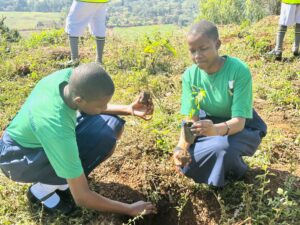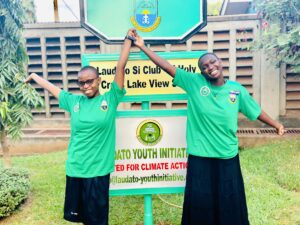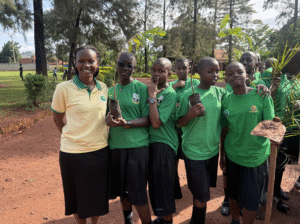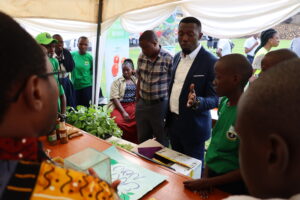“What Is Happening to Our Common Home?” – A Laudato Youth Scientific Initiative to Mitigate Pollution.
INNOVATORS
- Kyoyagala Alison
- Leeanne Kimberly
- Birungi Sophie
- Nairuba Sharon
- Mugisha Calvin
Mentor: Ms. Immaculate Kisembo

Background
Uganda, like many developing countries, is increasingly facing environmental challenges stemming from rapid urbanization and industrialization. Air pollution, water contamination, and land degradation have become urgent issues, mainly due to vehicle emissions, industrial waste discharge, and improper waste disposal practices.
These problems have resulted in serious public health risks, including respiratory illnesses such as asthma and lung cancer, floods as well as the spread of waterborne diseases. Additionally, poor land management has led to infertile soils, increased drought, and food insecurity.
This project is inspired by the urgent call in Laudato Si’ to care for our common home and evaluating what is happening in homes, schools, communities and Country at large. It and aims to contribute practical, youth-led solutions to mitigate pollution and restore ecological balance in Ugandan communities.
Problem Statement
Air and water pollution, along with land degradation, are severely impacting the health and livelihoods of Ugandans especially urban dwellers and students in schools and other institutions. Prolonged exposure to pollutants has led to rising cases of respiratory diseases and reduced agricultural productivity, threatening both public health and food security.
Project Objectives
- Reduce air pollution by promoting the use of catalytic converters in industrial machines and vehicles.
- Educate industry workers on safe waste treatment practices to prevent harmful discharges into the environment.
- Raise awareness about climate change and pollution through community outreach and school-based campaigns.
- Promote afforestation by encouraging communities to plant trees to absorb pollutants and improve air quality.
- Improve waste management by promoting responsible disposal practices and recycling initiatives.
Methodology: Research and Planning
- We have Conducted field research to assess pollution sources and their impact in our school local community of Wanyange.
- We are consulting environmental scientists and engineers to explore practical applications of catalytic converters and waste treatment technologies.
- We have set up a demonstration exhibition to help visualise the problem and raise voices for the rapidly growing pollution and will gather feedback from all who visit our table about their views to the escalating pollution in Uganda.
- We will develop educational materials for the media on pollution and arrange climate change debates targeted at schools, industries, and local leaders.
- We want to invite the government and local organisations interested in mitigating pollution to form partnerships with us in order to amplify our voices further through the media, environmental NGOs, and faith-based organizations to scale the initiative.
Phase Two: Design and Implementation
- Design Phase: Develop diagrams and models illustrating various types of pollution, their causes, and impacts. Started
- Implementation Phase:
- Install demonstration catalytic converters on selected industrial and school generators.
- Launch tree planting campaigns in schools and urban communities. In going
- Host awareness workshops and seminars with industry workers and students. Coming soon!
- Create a media campaign (social media, radio, posters) to spread information on pollution solutions and climate action. Ongoing
Expected Outcomes
- Increased public awareness of pollution and its health and environmental effects.
- Adoption of pollution control technologies in selected industries.
- Reduction in respiratory-related illnesses among students and community members.
- Improved waste disposal practices and greener public spaces.
- A growing network of Laudato Si-inspired environmental youth leaders.
Sustainability and Monitoring
- Establish more Laudato Si Clubs in schools and communities to continue awareness efforts.
- Partner with local authorities to monitor air and water quality improvements.
- Conduct quarterly reviews with stakeholders and community leaders to assess progress.
- Seek support from environmental grants and donors to expand the initiative.
Conclusion
This project presents a youth-driven, science-based approach to pollution control in Uganda. Through education, innovation, and community engagement, it aligns with both the Sustainable Development Goals (SDG 13: Climate Action) and the values of Laudato Si’, encouraging responsible care for our common home.
Your message has been sent














